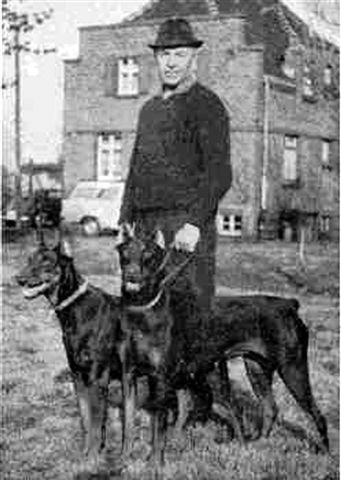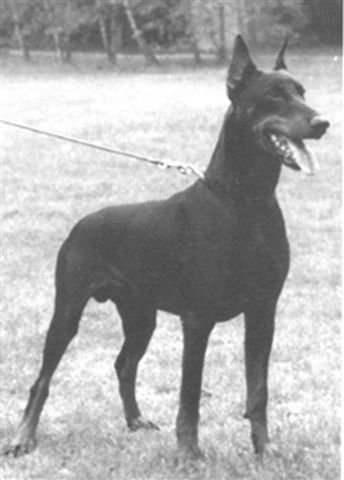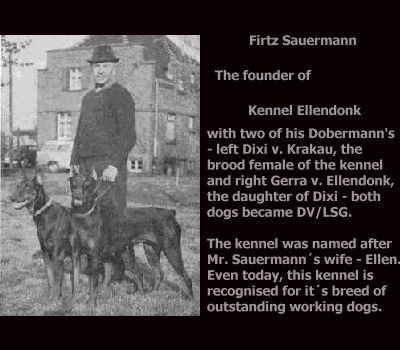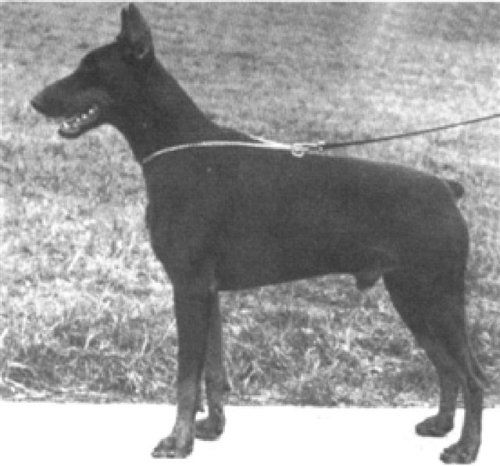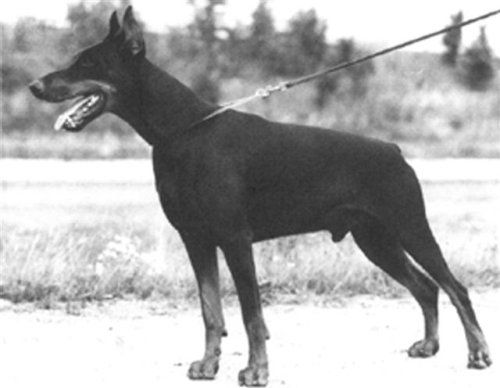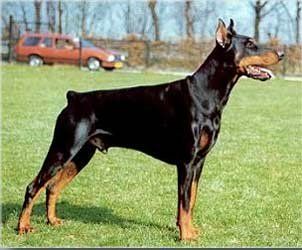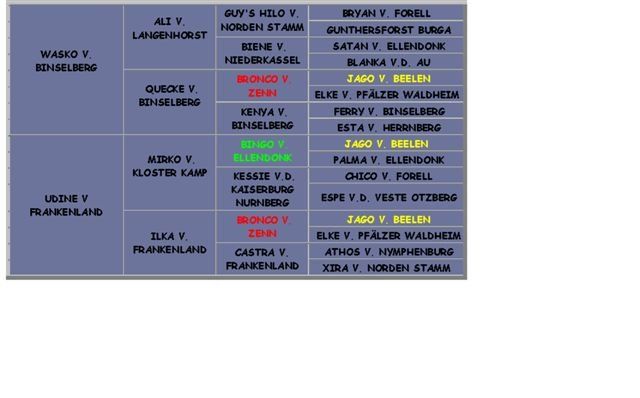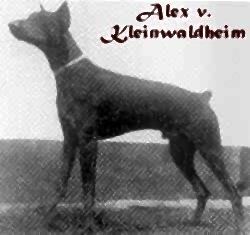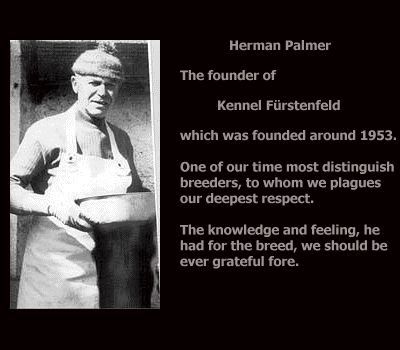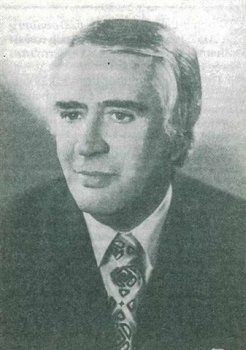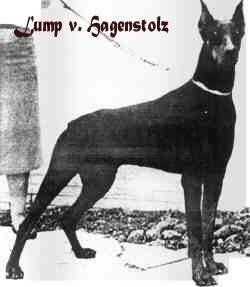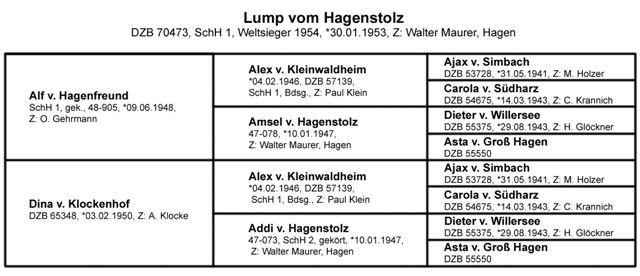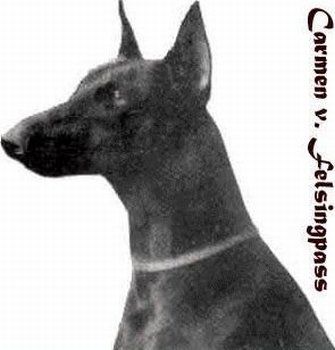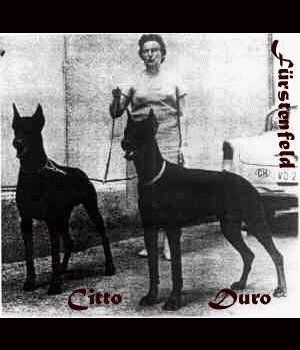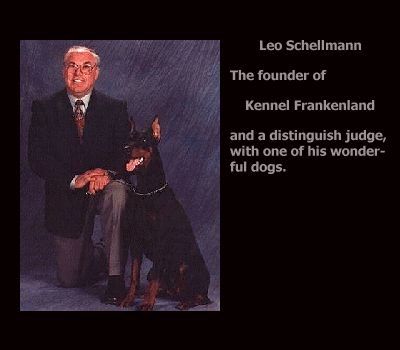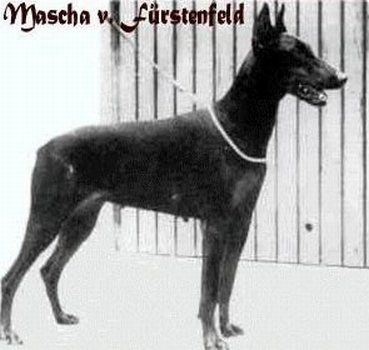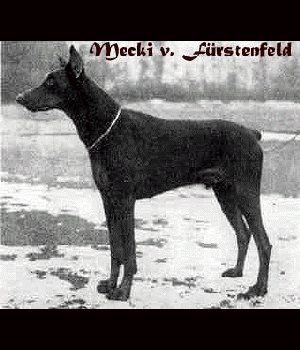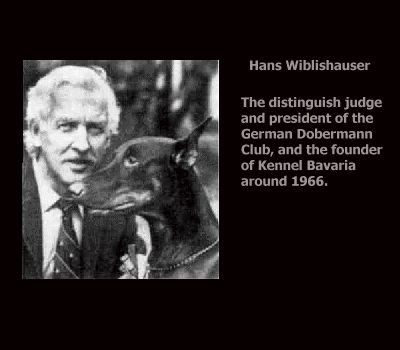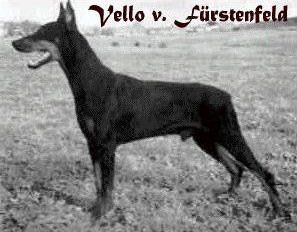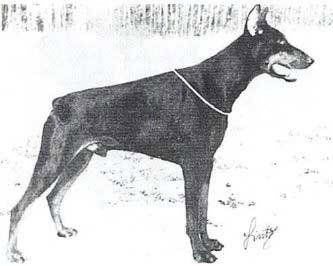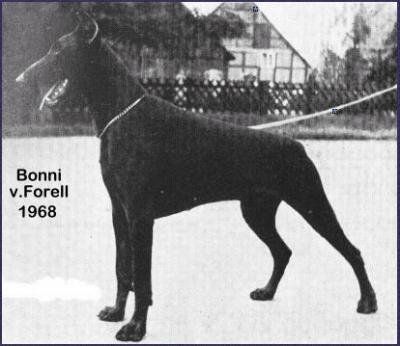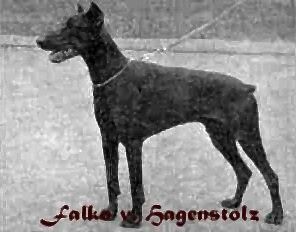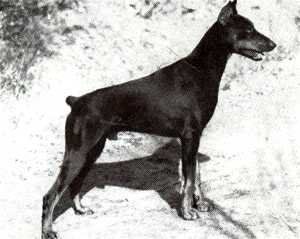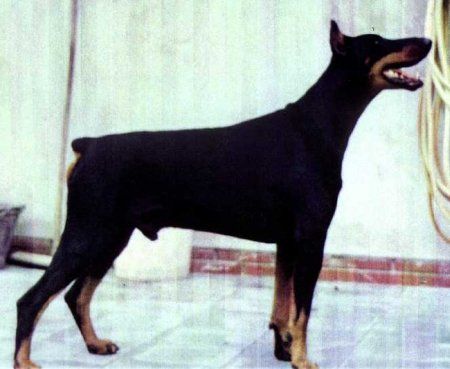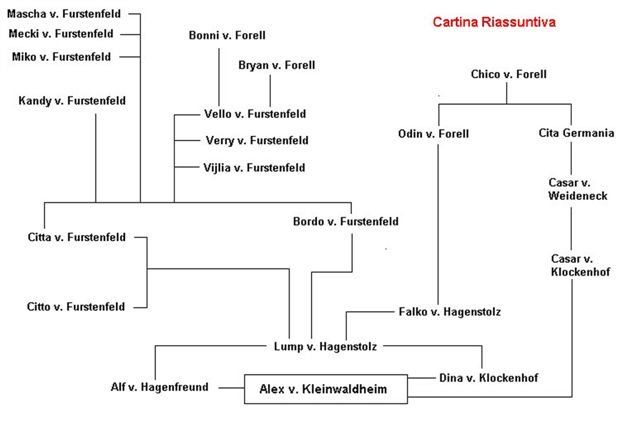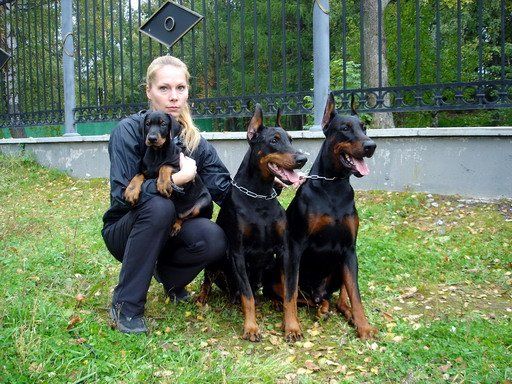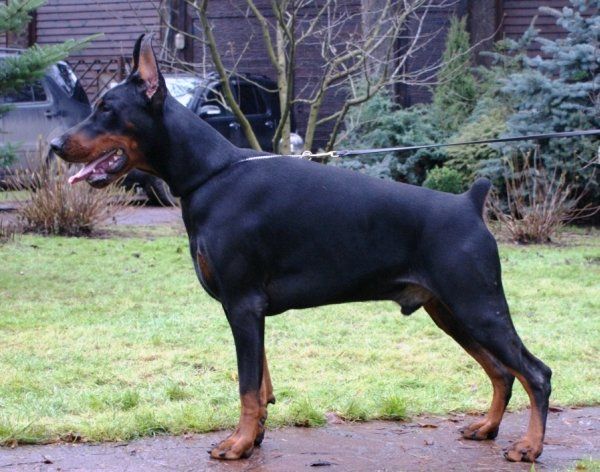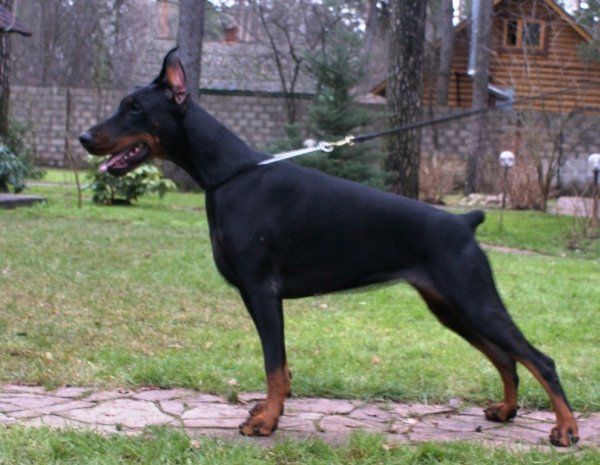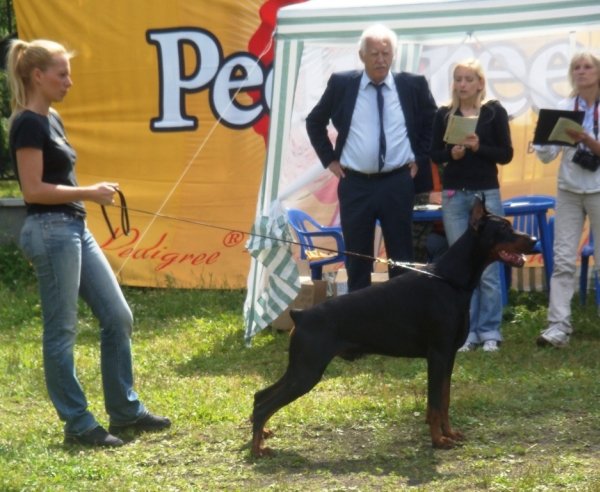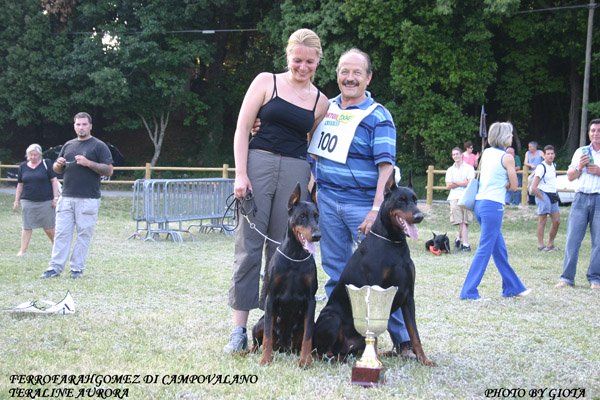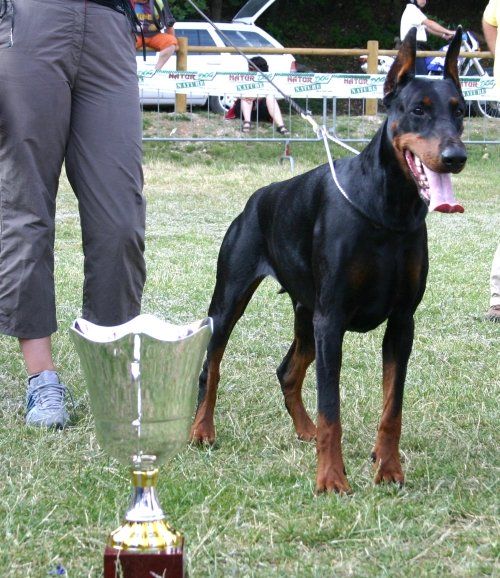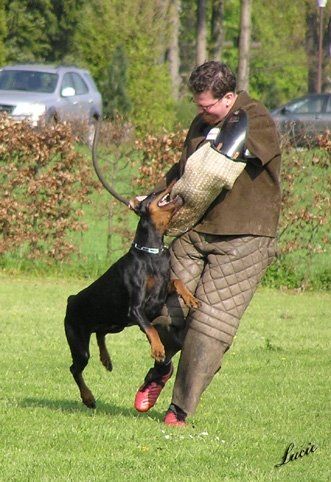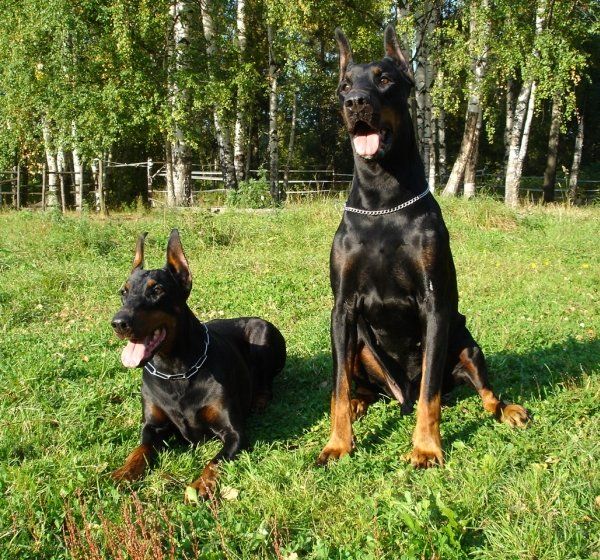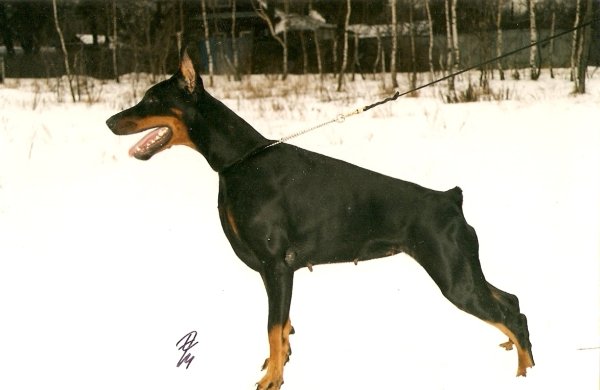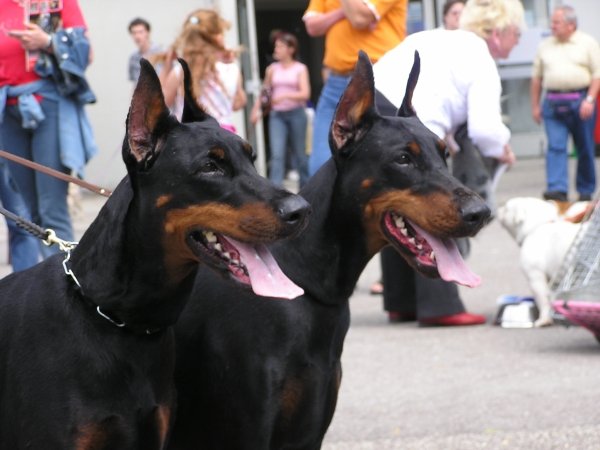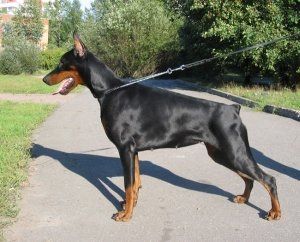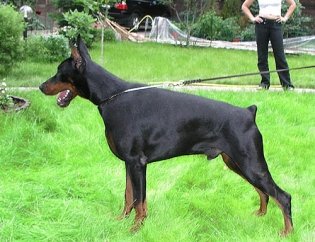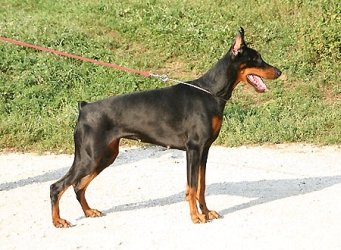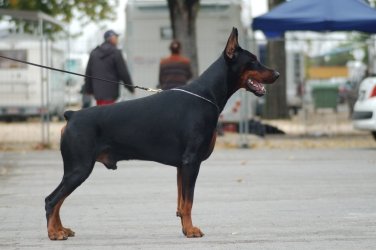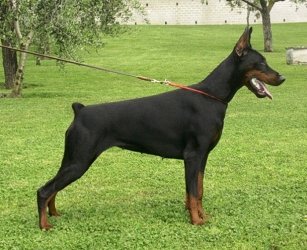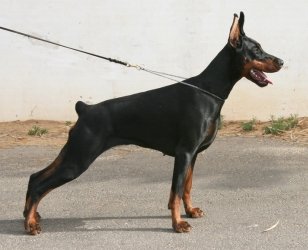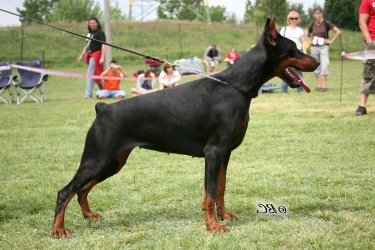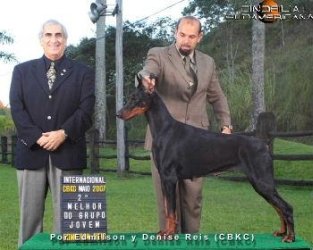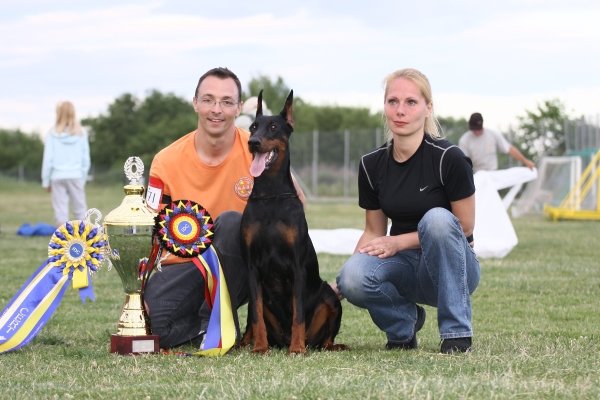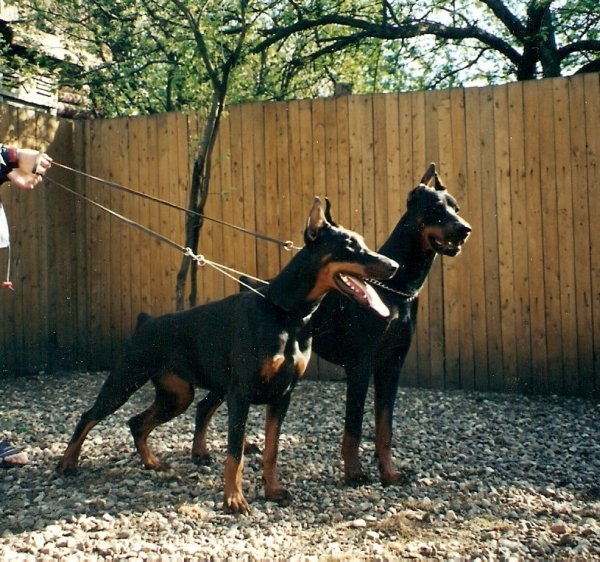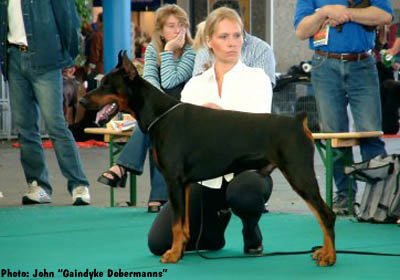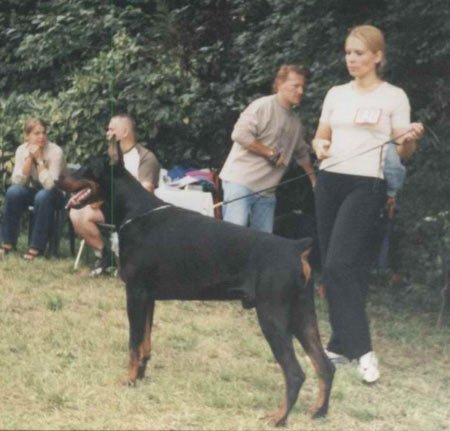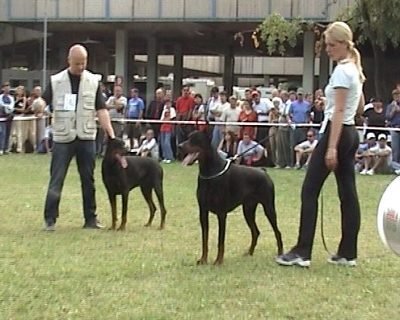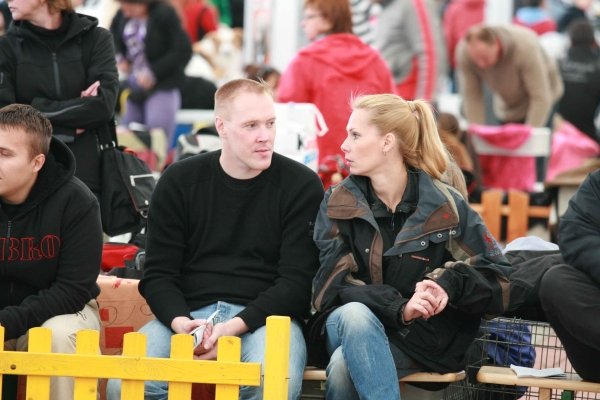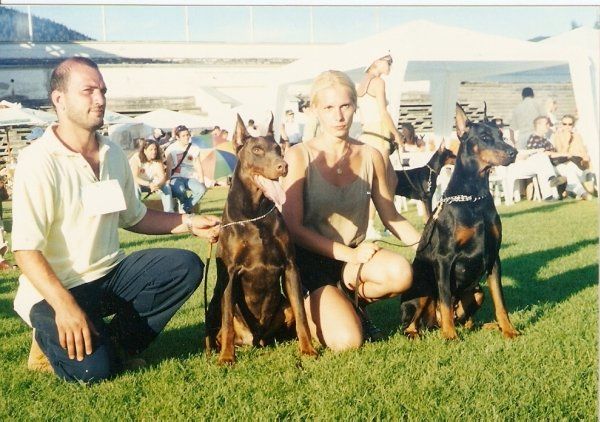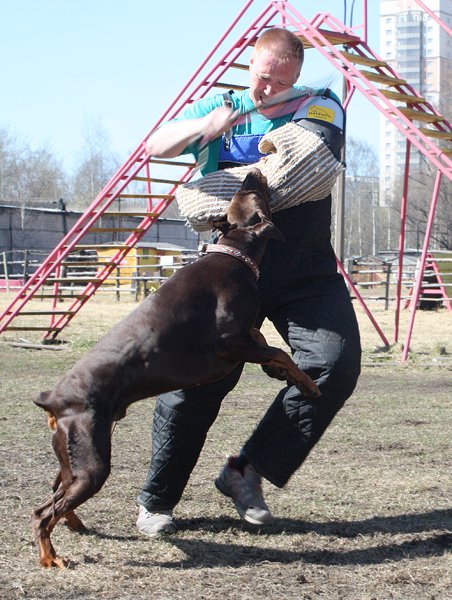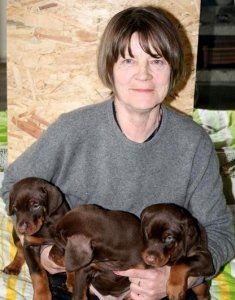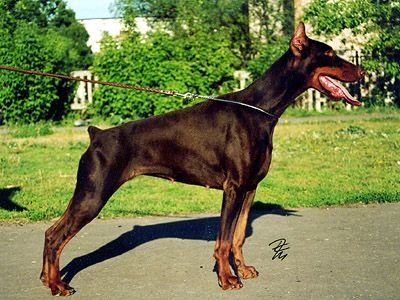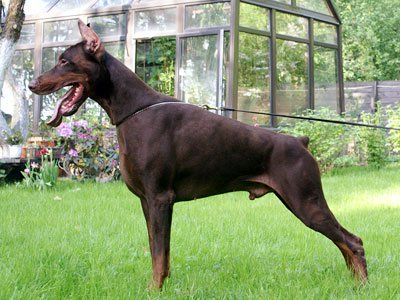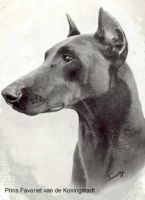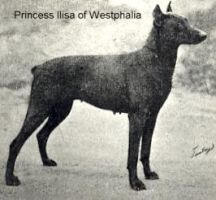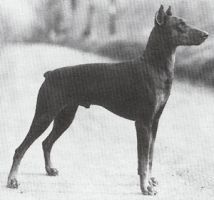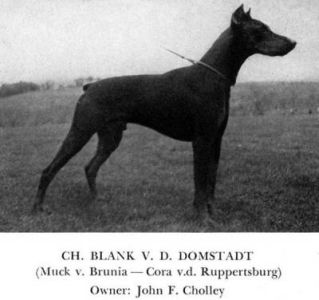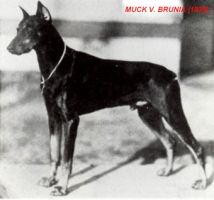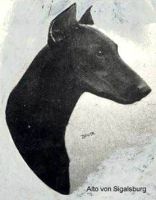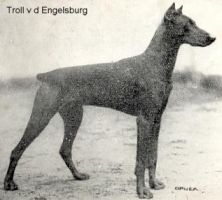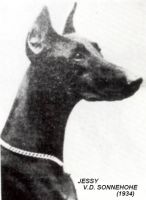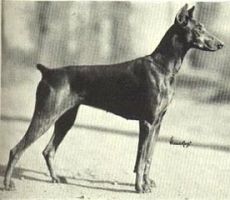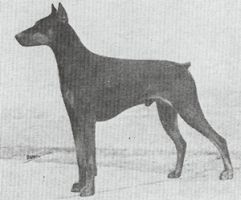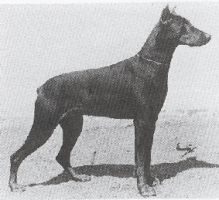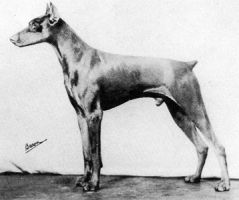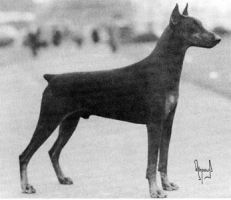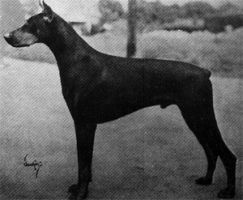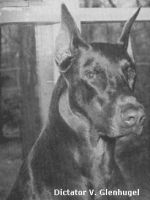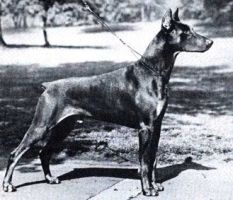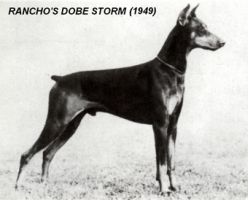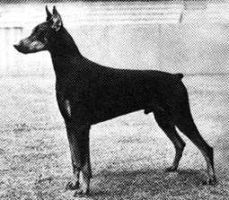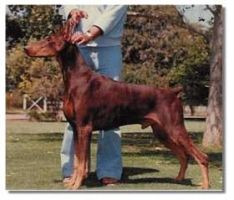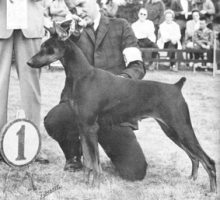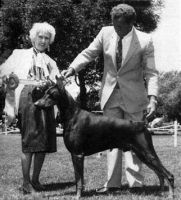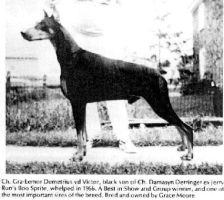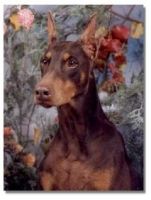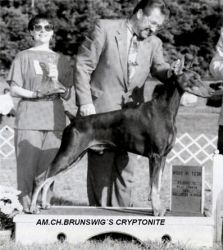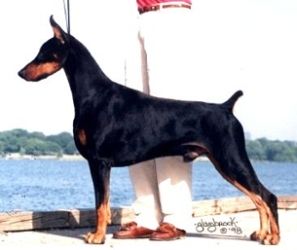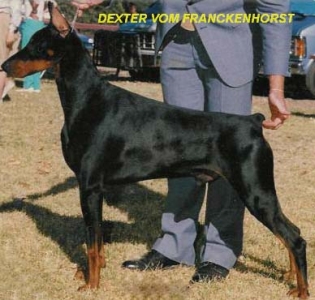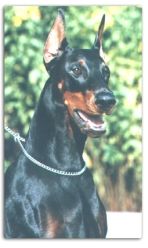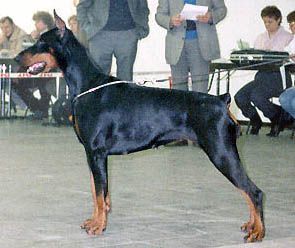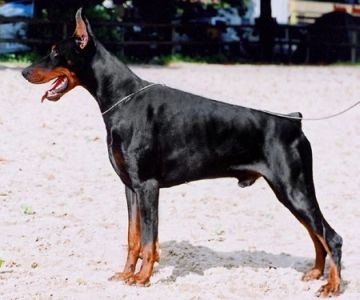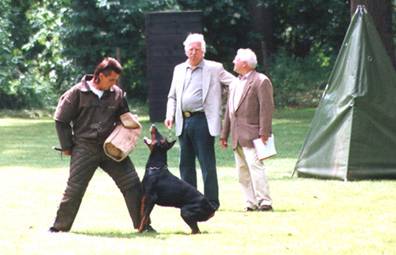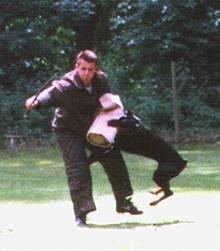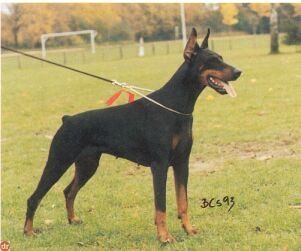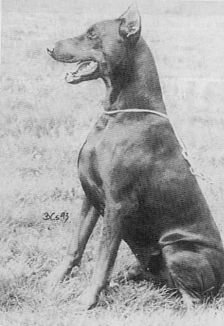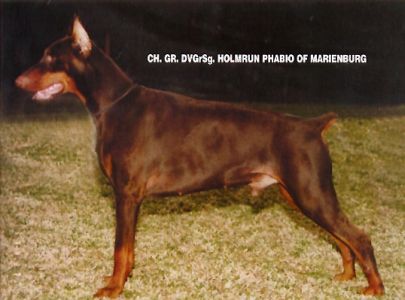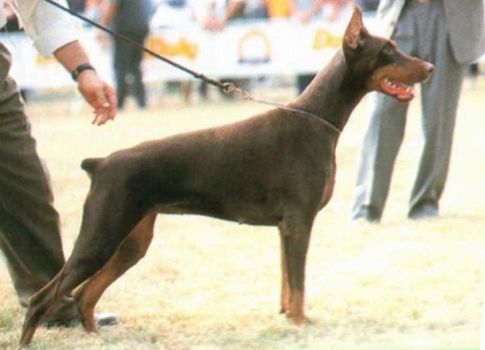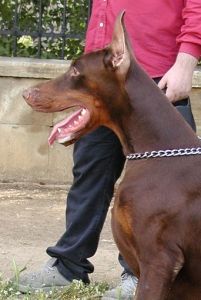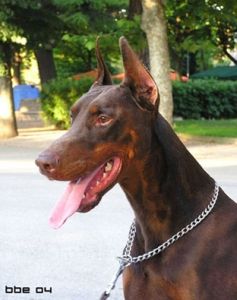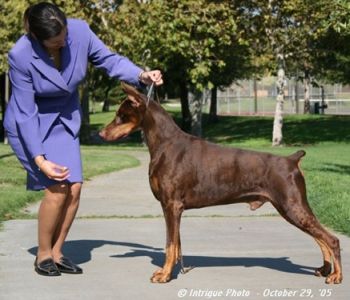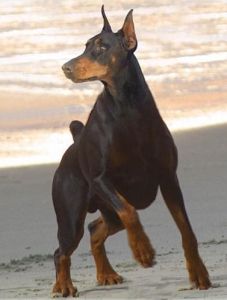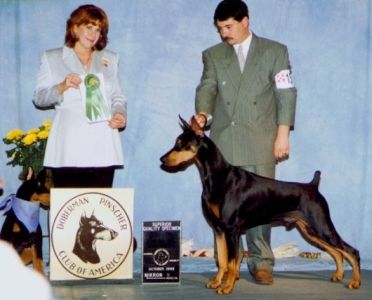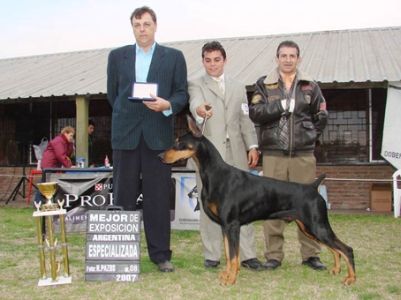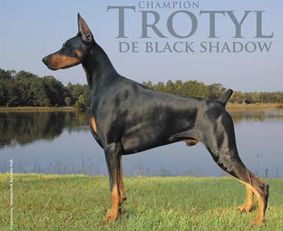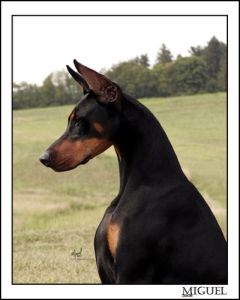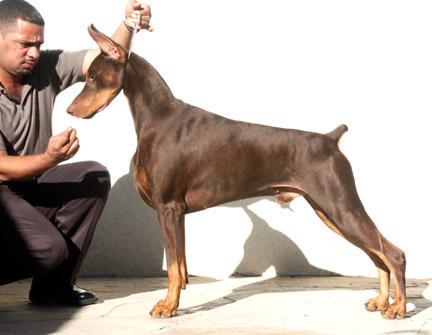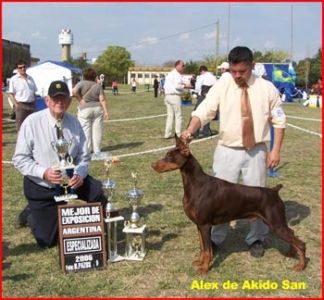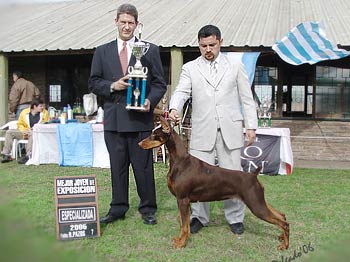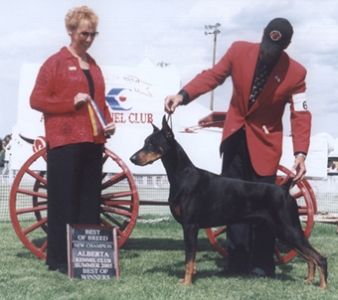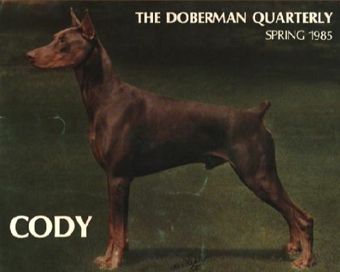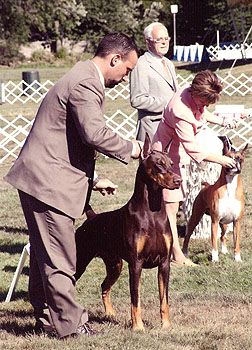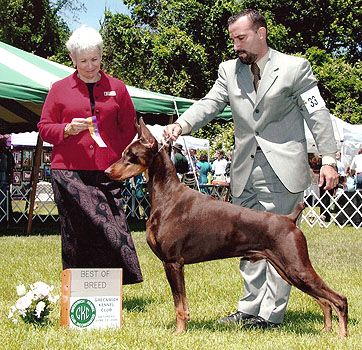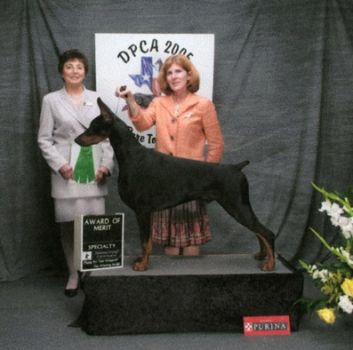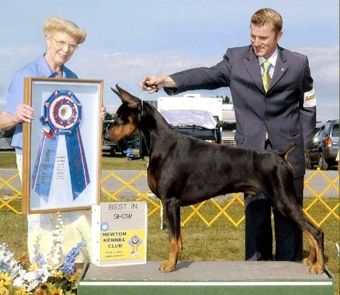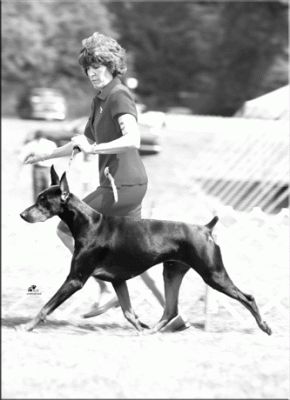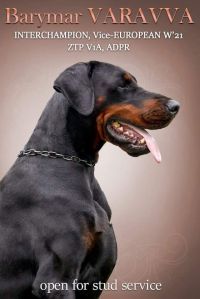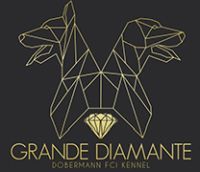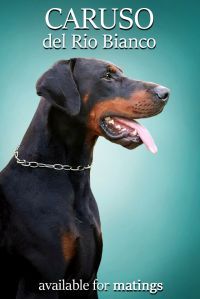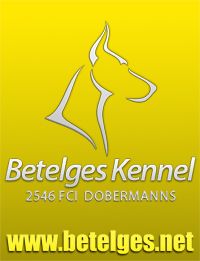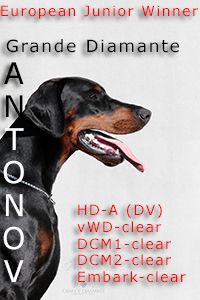Essential elements of the type that characterize the dobermann breed and judgment criteria
by Pierluigi Pezzano
Learning is not an event
Knowledge cannot be gained through a single event; in fact, it is the result of a continuous process of learning. So it is in every field and profession. For that reason, it’s not easy to judge or to breed. To judge correctly and to breed properly requires having lived some efficacious experiences through which we can gain the right conclusions that we can revise and continually improve by study and comparison. This allows the judge and the breeder to take part in the process of selection and genetic improvement of the dobermann and to decide on it.The official zootechnical evaluations (shows, aptitude tests, work tests) are useful for choosing – according to what is available from the phenotype – the best specimens for breeding and for excluding from it the ones that are presumed to be deteriorating.
Actually, it is the judgement to influence the breeding and both them work on selection and breed improvement. The judgement in canine zoognostic is the expression of an attentive and consistent evaluation written in a concise and complete way, that must correspond to a qualification and, if there’s comparison, to a list.
However we have to keep in mind that when we judge dogs, the quality of the judge’s decisions depends on the interpretation of the standard of the breed according to his ability in order to:
- choose the best dogs able to realize their mission in life;
- choose the more typical ones, starting from the evaluation of the constitutional type and of the breed.
The dobermann selected must be the best one on both these aspects.
Anyway, this choice cannot be arbitrary but, on the contrary, it must be closely connected with the precise principles stated by the standard of the breed. The judgement is the most important aspect, since a wrong judgement brings to wrong conclusions not only as far as the aspects of the morphological-functional evaluation are concerned, but also the character. I’m talking about morphological-functional evaluation because beauty, about dobermann, is essentially functional beauty, that’s to say of adaptation.
This means that the standard requires the dobermann to have all those qualities that make him able to obtain the best performance with the minimum effort in the function he has been created for. So, the characteristics that take to concept of beauty are those that have a fundamental role in order to determine the breed type.
The type is the essential element and if a dog lacks it he doesn’t belong to that breed anymore and he cannot be judged. Therefore with a dog who lacks in type or scarcely typical with such a dog we cannot breed. The ZTP test for the dobermann is based upon this principle. So we must explain clearly what we mean about the type. The type is the sum of the relative qualities required by the breed standard for each region of the body, in the respect of the fundamental elements constituted by the proportions between: height-length; height-body mass; height at the withers – length of the body; height of withers – height of chest and by the notes about character and behaviour that are included in the standard. The ideal type is obtained by respecting precise zoometric, physical and aesthetic parameters and avoiding excessive reinforcements that can cause damage to the image of the breed and, above all, to its use.
In fact, the characteristics of the type concern both the structure and the movement and the nature and the basic qualities of the dog.
To have a good eye for judgement
The judge has almost three minutes to evaluate each dog and to choose the more typical, with well developed secondary sexual characters, medium size and the most harmonious. So it’s easy to understand that a dog who is properly showed has more chances. The first questions a judge should make himself whilst evaluating a dog are:
- Is he powerful, elegant, alert, self confident, muscular, with a proud behaviour?
- Has he a compact body?
- Is the length of the body proportioned to the height of withers?
- Are his transverse diameters well proportioned to the longitude ones?
- Are his angles and his forequarters and hindquarters balanced?
- Is his head in the right proportion to the height of the withers and of the chest for length and volume?
- Is the length of the neck in the right proportion to the height of the withers and to the body?
- Has he excellent bones, dry and strong?
All that to give answer to a single question: “Is he harmonious?”
Many dogs have the lower line longer than the upper line. This can be caused by an anterior angle too open that makes the dog appear longer than he really is or by a thorax hardly developed in height. Other dogs appear to be exactly square, but what about their croups? And their hind angles? Some others have enough long forequarters and narrow chests, is it serious?
All these questions have precise answers that every breeder or dog lover should be able to give if they think and try to reason them out . Instead, this kind of approach should belong to a judge as an expert, it should be part of his judgement criteria and of his professionalism.
Thus, to a judge the first impression is the dog on the whole, I’m talking about a judge who has a good eye for dogs. That’s to say that the judge is so mentally skilled and well trained that his brain, unconsciously, can catch the global image of the dog and immediately perceive the presence or the lacking in qualities.
This makes the difference between an expert and a beginner: the expert realizes immediately what the beginner can see only at the end or can perceive by chance. Having a good eye for dogs is not a gift from nature, on the contrary it’s the result of a process slowly acquired.
The observation about having a good eye, that we often hear at the ring, can be interpreted as the ability to make choices agreed by the public but without knowing the reason why. However this means “consensus on the judgement”, it’s nor science nor art. It’s important to have a good eye for something that other people approve, but to know why a particular characteristic is better than another is something very different from that.
The expert judge is the one who can explain his choices by giving objective, convincing and technically incontestable reasons. To do that, besides having a high competence and knowledge about the standard, the anatomy, the canine zoognostic, the genetics and the zootechnics, the mechanics and the kinematics, the judge has to know the history, the present of the breed and the objectives of breeding too. That’s to say that he must know the point we started from, the situation we are and what we want to achieve. From this point of view, it’s up to breed societies to give the measures, also by giving guide lines and criteria.
The analytical evaluation
In judging the dog by standing still, it would be better to subdivide the body of the dog into three parts head, body, and limbs, that are still subdivided in regions and sub regions. Each region must be identified, localized and limited on its relations with the surrounding regions and it must be described regarding its shape, position, length, height and direction in order to infer its qualities or faults.
The analytical evaluation of a dog is based upon the careful observation of each region and sub region and the relations that are involved in forming the whole of him, unique and indivisible. The harmony of the whole comes out from the harmony of the single regions and sub regions, and in every breed it corresponds to a function that justifies the standard.
The concept of harmony is essential, above all in the dobermann. In fact, the evaluation of the harmony of the whole is fundamental to the criteria of judgement since it also forms the basis of the judge’s ability to recognize whether a dobermann corresponds or not to the constitutional breed type, even before starting analysing the single quality and fault. The constitutional breed type is deduced from the standard, and it’s defined by:
- the examination of the diametrical proportions;
- the examination of the structure: body mass(weight + volume), referred to height;
- the examination of the outlines;
- the examination of the harmony of conformation.
The evaluations of the outlines, the proportions and the structure so as the relations between the single regions and the height at the withers, are subject to precise scientific rules. Therefore, the cornerstones of judgement criterion must have precise and certain references into the standard of the breed and in the scientific dictate. It’s the same for the basis of the principles of genetic improvement, any other criterion or method are wrong.
The dobermann, as described and requested by the standard, is a galloping breed, with an alert temperament, a very developed cleverness, proud and self confident in every situations. His general appearance is of medium size, with a correct equilibrium between strength and elegance. So he must appear strong and muscularly built, powerful and elegant (by preferably being in the medium size accepted by the standard about the two sexes: 70 cm in males, 65/66 cm in females).
His body is almost square, this means that in the dobermann the length of the body measured from the tip of the shoulder (shoulder blade – humerus articulation) to the tip of the buttock (ischium) is almost equal to the height at the withers. So, regarding his structure, the dobermann is an harmonious galloper, that’s to say that every regions of his body must be well proportioned in length, height and breadth, to the height at the withers and to the body as far as the volume and must have the right direction in comparison with the reference directrix.
In the dobermann, the relations among the single regions are scientifically and coherently determined by that reason that he is a medium size galloper,, harmonious in his structure. Some examples of disharmony are: short head by comparison with the height at the withers or little in proportion to the body, back not well proportioned with the front, neck too weak by comparison with the body or too short in relation to the height at the withers, too little chest or too long forequarters in relation to the height at the withers.
 The dobermann is also harmonious in his outlines, that must be straight, that’s to say without interruption or jolts or tooaccentuate height differences. The outlines that we must consider in the judgement are those of the head, the lips, the neck, the back, the croup, the legs, the chest and the abdomen.
The dobermann is also harmonious in his outlines, that must be straight, that’s to say without interruption or jolts or tooaccentuate height differences. The outlines that we must consider in the judgement are those of the head, the lips, the neck, the back, the croup, the legs, the chest and the abdomen.
The dobermann’s diametrical proportions are inferable by comparing the longitude diameters with the transverse diameters; these relations must therefore be those of a medium size galloper. When the transverse diameters prevail in a visible way we have the strong meso-morph type (shorter bones, fore chest excessively large, muscles developed in high rather than in length…); on the contrary, if thelongitude diameters prevail, we have the dolicomorph type (too long limbs, light head for length and volume, narrow fore chest, little developed chest in height, short and too much sloping croup, too rampant body top line, too much tuck up under line, light bones…). We must pay great attention to all that since at the base of the dobermann genetics there are both dolicho morph and strong meso morph dogs. In particular, we can represent that same genetic base by the geometric shapes hereby represented, from which it’s easy to realize the presence of Alex von Kleinwaldheim as common ancestor of all modern who still influences greatly and negatively the background inbreeding of many of them.
Prof. Giuseppe Solaro used to say that the judgement should begin from the tip of the muzzle and finishes at the tip of the tail, going through all the regions of the body. Experience teaches the judge to synthesize in the judgement the positive and the negative elements that will determine the dog’s classification. I think that the real difficulty to judge correctly is that it’s easier to recognize the qualities rather than the faults in a dog. Maybe this is the difference, not even so thin, that marks the boundary between the expert judge and the profane. This should avoid seeing winning dogs with few faults but without qualities and class (style).
We have already said that the judge, in the course of his job, has to comply with the standard of the breed because in it are described the normal type, that’s to say the ideal of the breed. I know well that the normal type is rare, anyway he’s the ideal to search for according to the morphological harmony and to the function. So, the best way to be useful to the breed is to try to achieve the type as described by the standard, through programs of breeding, shows and zootechnical tests. Working in a different way from this, means to make damage to the breed and also to their own breeding. I’m referring to the fact that some dog lovers, judges and breeders appear to be likely to exaggerate in the search for some characteristics of the type and do not pay the necessary attention to a correct selection of the normal and harmonious dobermann as described by the standard, promoting exaggerations of the type rather than recognize the quality in its right measure.
In order to that, we must keep in mind that, in the dobermann, any deviation from the normality stated by the standard alters the harmony of the whole and or the function or a relative virtue, and, because of that, it must be considered a fault to be penalized according to its deviation from normality. Therefore, also each characteristic exceeding the type, that’s to say the hyper typical regions or sub regions are to be seen as a fault, since they alter the proportions or modify a relative virtue and don’t conform with the standard.
It also happens that many people often confuse the absence of type with the hyper type. In fact, it’s wrong to classify as hyper type, for instance according to the characteristics of his head, a dobermann with a short muzzle and with a large and globular cranium. Who reasons in this way is certainly wrong, because he considers as hyper typical a head that in reality is out of type. Indeed, the hyper type, is the result of a genetic or environment forcing of a virtue, never of a fault. Hyper typical is a head 4/10 longer than the height at the withers, in which, for instance, the muzzle line is longer than the skull line, while the other relations are well kept. On the contrary it’s typical a head quite correct in proportions, axes, volume and outlines, even if longer than the height at the withers: “very good long head, parallel, shaped in the form of a blunt wedge and well proportioned, even if a little disharmonious compared with the height at the withers”. The same head with a muzzle line shorter than the skull line, or presenting another, not serious, fault in the proportions or in the lines, cannot be considered nor typical nor hyper typical; we can say that it is fairly or enough typical, but never very good or excellent. Once more, in the dobermann, we can consider hyper typical an eyelid with a tendency to bend inside to show an entropion, whereas this breed requires a thin and close lying eyelid, in a semi-lateral position in relation to the median axis of the cranium. This example, but it’s not the only one, represents also the case in which a deviation towards the hyper type can lead to disqualifying defaults. Now let’s take fore chest and chest into account.
The fore chest is large, wide and muscular. Its width, measured at the upper front arms edges, must reach 25% the height at the withers. The manubrium of the breastbone must stay at shoulders point level.
The chest must fall well (well developed in height), it must reach the elbow level; the ribs are long, well arched and oblique with well wide inter costal spaces. The lower edge of the fore chest, which overlaps with the lower edge of the breastbone, is long and its line makes a large chord semi circle that goes up towards the abdomen. The circumference of the chest must be almost ¼ more than the height at the withers.
When the dimensions of the breast and chest are very smaller than the expectation and the whole forepart, from the ground to the tip of the funny bone is too long, that’s to say that it greatly exceeds the 51% of the height at the withers, everybody agrees that that dobermann is out of the constitutional breed type.
Instead, it’s often considered as hyper type a dobermann with excessive transverse diameters, very wide chest, very large fore chest, powerful musculature and strong bones. I think this is a wrong way to reason about. In fact, if we consider the function and the speed normal dobermann must develop, I mean a dobermann corresponding to the standard, it’s easy to understand that even the dobermann who has been built to develop strength and not speed is out of the constitutional breed type, since he is slow and powerful, not rapid and full of temperament.
In order to the normality and the hyper type, our late lamented dr. Valter Gorrieri wrote: “Milo, the great sculptor and harmony teacher, whilst modelling his Venus’ proportions, breast and gluteus, had the ability to limit the dosage without falling in those temptations that would have brought him to vain emphases, to form an ideal feminine beauty. Mirone followed these same principles sculpting his Discobolo. Both the artists shaped the image of a woman and of a man who, with exemplary normality, expressed an absolute virtue”.
According to all that, I think that the general characteristics that define the dobermann can be summed up in a few words: “His general conformation is that of a meso morph with a perfect equilibrium between powerfulness and elegance, his body appears to be almost square, his structure and outlines are harmonious”.
His principal characteristics of the type are:
- the head is chiseled with parallel upper head axes;
- the stop is well defined;
- the eyes are middle size, oval, very expressive and semi lateral;
- the cranium is flat;
- the muzzle has lateral surfaces fairly convergent, with a straight upper line, well tight flews;
- the ear is set high, cropped and carried erect (if not cropped, it is flat, triangular shaped, lying close to cheeks, its length is less than a half of the total length of the head);
- the withers are well pronounced;
- the neck is elegant, pyramidal shaped, softly curved at the upper outline;
- the upper outline of the body falls gently from front to back;
- the skin is thin and fits closely all over;
- bones and veins well visible under the skin;
- the hair is short, naturally shiny.
We must give the same importance to the size required by the standard and to the weight of the dog that, in comparison with the height, tells us which his mass is. Size, mass, character and natural qualities of the dobermann strongly influence his way of being from the point of view of the morphology, the functionality and the dynamism.
The Italian school and our culture about selection and the about the morpho functional evaluation of the dobermann are essentially based upon three fundamental concepts:
- the dobermann breeding is based upon his equilibrium, his natural qualities and his being typical;
- the head tells about the breed;
- as stated above, points 1 and 2, the dobermann with a good character and who is closer to the normal type and moves better must win.
The statement “the head tells the breed” seems superficial or evident, on the contrary, if we reason from a technical point of view it’s easy to prove that, while evaluating the particularities of the type, and therefore the qualities of a pure bred dog, the number of regions and sub regions of the head, in comparison with the body, represents the large part of the whole.
In fact, 22 of the 57 regions that form the body belong to the head.
So, it’s not wrong to say that the structure of the regions and sub regions that form the head marks for the great part the type of the dobermann. Naturally, the type of the head is not only due to its length and to the relation between the length of the skull and le length of the muzzle, but it’s due to the type and to the harmony of all its regions. One thing is to say “long and well in proportion”, other is to say “very typical head, parallel, well chiselled, shaped in the form of a blunt wedge, long and well in proportion and well detached from the upper edge of the neck; strong muzzle and jaw, tight lips; oval eyes in semi lateral position, dark ochre iris; correct stop, large and straight muzzle; correctly inserted nose, nostrils with large openings and mobile; flat cheeks; flat cranium; forehead furrow well visible; well contained zygomatic bone; eyebrow still visible; correct Occipital line; ear set high and well carried; thin throat…”.
The dobermann ’s head is dolichocephalic; this means that its longitudinal diameter is more developed than the transverse one. Its total length (measured by the compass or then ruler from the upper front edge of the muzzle to the medium external point of the Occipital crest) reaches the 4/10 of the height at the withers; the length of the muzzle must be a half of the total length of the head, so that the one half of the total length of the head falls upon the horizontal line that links the interior angles of the eyes.
The width between the two bone arches of the skull must be less than the half of the total length of the head; therefore the total head index must be more than 45.
Head Index = Width x 100 / Total Length
Seen from the profile and from the top, the dobermann’s head looks like a blunt wedge; seen from the side we can appreciate its upper outline that is straight like all the other outlines of the dobermann. About the head the straight profile coincides with a perfect parallelism between the axis of the skull and the upper axis of the muzzle.
I want to use this occasion to give, according to scientific basis, a correct definition of these two axes or ideal planes, since it seems to me that many people still don’t know exactly how to individuate and to read in a way technically corrected the parallelism, the convergence and the divergence. I have seen recently a comment on the standard published by the American Dobermann Pinscher Club (they still call the dobermann “dobermann pinscher”…), with some drawings, very precise and very fine, but partly absolutely wrong, as wrong is the great part of the concepts that describe the salient points about the structure and the type of the breed.

The head of all the dogs in the world submits to three upper outlines: straight, concave and convex. These outlines depend on the relation between the upper longitudinal axes of the skull and of the muzzle. This relation is called parallelism or convergence or divergence. The profile of the dobermann’s head is straight, like all its other outlines. This means that the upper longitudinal axes of the skull and of the muzzle are parallel. When the upper axis of the skull meets the upper longitudinal axes of the muzzle there is convergence. When the upper longitudinal ax of the muzzle meets the upper axis of the skull there is divergence.

In fact, in these drawings by prof. Giuseppe Solaro, that represent the parallelism of the Setter, the mono convergence of the Pointer and the very marked divergence of the Italian Bracco, we can clearly see that the upper axis doesn’t not coincide with the upper outline of the skull, on the contrary it consists of the straight line or of the ideal plane that passes from the craniometrical point inion (corresponding to the medium external point of the occipital crest) to the craniometrical point nasion (corresponding to the point where the nasal bones meet the frontal bones). The axis of the muzzle, on the contrary, consists of the straight line or of the ideal plane that follows the upper outline of the muzzle, by linking the upper anterior extremity of the to its posterior extremity, that is at the halfway point of the transverse line that links the internal angles of the eyes.

It’s often a little difficult, for those who don’t have a practised eye to catch the exact reference points, to say whether these two ideal planes or ideal lines are parallel or not, even because, looking at the dobermann’s head from side, the inion and the whole Occipital crest are invisible because hidden by the ears. In this case, a good method is to observe the upper axes while the dobermann is moving with his ears turned back. So everything will be clearer.
I don’t want to give a particular attention to the faults of the head because, as I have already said, about it in Italy we have a good knowledge and good tradition that we ought to emphasize by further improve our products. However I’d like to point out the necessity of paying a particular attention not only to the proportion between the length of the skull and the length of the muzzle (many muzzles are still short) but above all to prominent noses in comparison with the front face of the muzzle and to thin and insufficient jaws often optically hidden by too developed lips rather than by a fleshy chin. These faults, partly improved during the last ten years, go together they are serious not only if considered themselves but because a pointed muzzle and a weak jaw usually denote a certain tendency towards undershot jaw.
When this is absent, we often see lower incisors extremely inclined or little, in order to correct the shortness of the jaw.
 On the subject of tooth, it’s all right to pay attention to the alignment of the incisors during the first three years of life of the dog, but it would be more useful to pay the greatest care to the right shot between the incisors and the pre molars. In many dogs, the canines are too separated and the pre molars close badly. The judge should always notice these faults and penalize them according to their gravity.
On the subject of tooth, it’s all right to pay attention to the alignment of the incisors during the first three years of life of the dog, but it would be more useful to pay the greatest care to the right shot between the incisors and the pre molars. In many dogs, the canines are too separated and the pre molars close badly. The judge should always notice these faults and penalize them according to their gravity.
About that, we must consider that the faults concerning canines and pre molars that close badly often seriously condition the shot of the mouth and also the correct occlusion of the lower incisors with the upper ones.
As far as the evaluation of the head, I only want to add two things. The first one concerns the eyes, the second is about the under orbital region. In a dog, the position of the eyes is very important because it is closely connected with the conformation of the orbits and of the skull, so it is a very important index of type. In the dobermann this position is semi lateral, even if to the minimum, according to the median axis of the skull.
The eyelids are close lying and middle sized. They must be oval, neither round nor slit. The interior angle of the eyelid must be at the same distance between the front edge of the nose and the extreme external tip of the occipital crest. Therefore, there many dogs with eyes in sub frontal position and others in lateral position. Faults as such, fortunately not too common, are serious since they disfigure the expression of the breed. The eyes tell everything in a dobermann. His frank and direct look, expressive, ablaze and sometimes pushy, is his prerogative since it expresses the impetuous and generous being that characterizes our breed. However it’s very difficult to appreciate all that when we see a dobermann with little and deep set eyes.
This absolute fault (that so is for all breeds), that we find more and more frequently in Europe, is genetically passed on and it often exceeds in microftalm that represent an out and out disease. So it’s correct that judges and breeders pay the greatest attention to this problem.
According to the standard, the head of the dobermann, in each part, must not have wrinkles, the skin is thin and well close to underlying tissues, that’s to say absolutely soft and smooth, that makes you get a glimpse of the salient bones and the veins, as to emphasize its fine feature.
This means that the whole head of the dobermann must be very well chiselled. In particular, the sub orbital region is strictly connected with this concept since its characteristics are determinant to exalt the dobermann’s expression and his type.
The sub orbital region must be well chiselled; this means that it must have some protrusions that show a smooth and very thin skin, very little cellular tissue under the skin, muscles lightly developed.
The sub orbital region includes a semicircle under the lower edge of the orbits. Its anatomic base is the upper part of the mascellar bone, part of the cheek bones and the orbits. Above all that, to be well chiselled means that the base of the cheek bone is little developed and so is the upper mascellar bone, which thinness shows the shapes of the two molars and of the sub orbital hole.
All these shapes are more marked in a thin bone, as the dobermann should have, and are his particularities. Unfortunately the lack of these characters is rather common in Europe. It reveals thick skin, an exaggerate development of the under skin and muscular tissues as well as the mascellar bone and the base of the cheek bone, all that denotes scarce distinction: this fault is commonly called “kneaded head” or “not chiselled”.
The dobermann ’s neck is like a blunt pyramid with the base down and a blunt top where the head is connected. The length of the neck, measured from the nape to the cranial edge of the withers, with the neck in distension, must be at least equal to the length of the head, or it must at least reach the 4/10 of the height of withers. Down, the neck must widen gradually and harmoniously toward the body: such harmony depends on the position of the shoulder blades and of withers; only high withers and well oblique shoulder blades make possible this harmonious fusion both on the sides and in high. In the dobermann, the neck must be carried erect, proudly and with nobility. The neck must be well muscled and this is very important because these muscles condition the movement of the dog (head-neck balancing) and are important for the movement of the arm and of the shoulder and for the solidity of the dorsal – lumbar region during the movement.
A weak neck, fortunately rare to find in our breed, is a very bad fault in every breed; in fact, besides being disharmonious in comparison with the other regions of the body, it reveals weak physical structure and scarce endurance.
The dobermann’s neck, moreover, must be well dry – it must not have any skin pleats at the lower edge; its upper outline shows a light convexity that starts just after the end of the nope and disappears while extending towards withers.
Beyond the problems of flaccid skin that are diminishing in the last years, today we often see short necks, sometimes a little light, or cylindrical and a little flat, rarely weak necks, as already said. A dumpy neck gives the dobermann very ordinary features.
Both a short neck and a cylindrical one are bad, that’s to say that there’s no harmony in forming a whole with the next regions, in particular shoulder, withers and back. This is always due to a short and badly sloping shoulder causing also some important faults in movement: dogs that fall ahead, problems while moving ahead the fore limbs, centre of mass moving backward, etc….
Related to the structure, we must notice that short shoulder is often connected with a short arm little sloping and with flat withers. It’s easier to see the fault about a short arm; whereas the judge avoids evaluating the length and the inclination of the shoulder because it’s more difficult to do. However we have to keep in mind that the most serious fault of the forequarters is always the shoulder, because it is more determinant than the arm in the mechanics of movement. Another important factor that influences negatively the proportion of our dobermann is the forearm that is often too long. Unfortunately, as we I have already said, this fault often is accompanied by a deviation of the type towards the greyhound.
The dogs that have these faults must be penalized also in breeding since the excessive length of the forearm often alters the proportions between height and length of the dog and, therefore, the type (dogs shorter than tall with rampant upper lines). For reason of time, this can not be a complete argumentation anyway I want to announce you a forthcoming accurate treatise on this subject that I hope will arouse your interest. However, according to my objectives in writing this document, and even about the faults that nowadays characterize the dobermanns in Europe, I cannot leave out the upper outline of the body, the croup, the fundamental concepts about movement and, last but not least, the character. The upper outline of the body involves the back, the loins (kidneys) and the croup. Right now I want to say that, in every work breed, a well structured loin has one only correct outline: the convex one. In canine galloping breeds, that like the dobermann must have a very fast gallop, but also a remarkable endurance, the back outline has to be almost straight. By the dog’s anatomy we know that the function of the cervical ligament is to tense, lift up and give rigidity to the dorsal-lumbar part of the backbone. If this ligament is relaxed and weak, the spiny protuberances of the dorsal small bones converge towards their top causing the so called “saddle back”; in this case the dog has scarce endurance and is a little fast, on the contrary the “kyphotic back” is rigid and damages the flexibility of the spine causing difficult and skipping movements.
Unfortunately still nowadays there are dobermanns who show weak backbones even standing still. An excessively long and/or frail kidney can make this problem worse. On the contrary, the kidney must be short, large and wrapped in muscles. If both back and kidney are weak, the problem is serious and we must pay great attention in judging and above all in breeding. Another reason to give attention is the croup. About it, even if in the last fifteen years things have improved, there still are many dogs that have a short croup excessively sloping.
From a functional point of view, about the coup the slope is much more important than the length since it is fundamental for the movement. Such a consideration is not difficult to understand for anyone has elements of mechanics and animal physics of movement, even if approximate.
In fact, the croup in its essential skeleton base, (Ilium and ischium) is the region through which the back push is given, therefore, if the slope is bad the dog’s gait will be seriously lacking. A croup that is too sloping will condition the back push up even if the hindquarters and the angles are correct, nor it’s worth the attention some handlers have to force the dog to move with the neck lifted by the collar. When this happens, the good judge already knows that the slope of the croup and/or the shoulder and of the arm is wrong. The evaluation of the dog while he is moving (at an ordinary walk, at a little trot and at a fast trot) is useful to verify if the harmony the dog shows standing still is real or is apparent. The main faults about the gait a judge should pay attention in the ring, are:
- too razing gait, it is said that the dog walks too close to the ground when, because of a defective structure or problems of character, he lifts too little his limbs from the ground;
- wobbly gait, it is said that the animal wobbles when he moves in a marked way his centre of gravity to the side. This happens when the dog ambles because of a fault of the push or when he’s weak and tired;
- crossing gait, it is said that the dog crosses in the front biped as in the back, or in both them, when his limbs make a trajectory that is not parallel to the median ideal plane that cuts the body into two halves in length and are inclined to cross. As far as the front is concerned, this kind of gait can be considered defective when the fault is very marked since the dog, like all the quadrupeds, at trotting, takes always the limbs a little towards the inside as he is toeing in. On the contrary, as far as the hindquarters are concerned, any little deviation is a fault because they always must move parallel to the median plane of the body.
A gait is considered correct when:
- the rhythm is regular;
- the limbs move parallel to the median plane of the body;
- the movements are rapid and elastic;
- the articulations are in perfect harmony with the movements of the body;
- the horizontal and lateral movements are modest.
Behaviour And Character
The standard states about the behaviour, the character and the natural qualities of the dobermann:“The Dobermann must be fundamentally friendly and calm; he’s very devoted to the family and he loves children. In the Dobermann a medium temperament and a medium alertness is desired. The Dobermann is easy to be trained and he enjoys working and at the same time he must be courageous and show a strong character. Since the Dobermann is very attentive to everything happens around him and has an adequate reaction to circumstances, we appreciate the fact that he’s very self confident and intrepid”.
In order to the character, I want to tell in advance my personal belief: everybody talks about the character but just a few know its meaning. This is a big problem because, for instance, many breeders still believe to be able to judge themselves the character of their dogs, avoiding putting them to the required tests that are necessary to give an evaluation as much as possible objective.
On the contrary, I believe that to understand in a correct way the character of a dog or, much better, to realize his nature in its various aspects and individual particularities is much more difficult than pick out the positive and negative notes that characterize the same dog according to the type and the structure. The character and the natural qualities of the dobermann are well described in the standard, so every judge, breeder and dobermann lover should understand and know that this evaluation cannot be disregarded and must be done in the correct way before qualifying any dog and, above all, before allowing him to reproduction.
In a show the judge’s observation is objectively limited to the dog’s behaviour because the evaluation of the natural qualities and more in general of the dobermann’s qualities as a working dog are tested by the Ztp and the other sporting and training tests. So let’s see some behaviours or signals that are usual in insecure, nervous or fearful dogs.
In the ring some dobermanns show a great insecurity or fear when they are measured or when we control their teeth or their testicles, or more easily when the judge goes near him. Others, especially some females, show to fear their fellows.
From young class forward, dogs like those must be excluded from judgment and the same is for those dogs that show aggressiveness towards man or an excessive aggressiveness towards the other dogs. To tell the truth, in most cases it is a question of false aggressiveness or aggressiveness due to insecurity and fear.
I think the judge can avoid excluding the babies and the juniors who show insecurity or fear because, at that age, the character (genetic predisposition + environmental influence) is not completely formed. Moreover also in these classes the dog’s behaviour should be described and the qualification should be visibly influenced by it.
The experience in the ring should have taught to realize immediately any different expressions and insecure behaviours of the dobermann.
The first information can be given by the way the dog moves when he gets into the ring. In this phase we happen to see some dogs entering insecurely, a little stiff, walking “on tiptoe” that’s to say almost grazing the ground rather than putting the limbs on it strongly, securely and in a relaxed manner. Such behaviour, after having been verified during the judgment through other signs, in most cases will demonstrate that that dog is insecure.
There are other dobermanns who dilate the eyelids and lay bare the cornea as soon as the judge goes towards them and before he touches them, moving jerkily the ears laterally backwards and visibly lowering the tail, these are signs of serious insecurity or fear. The same is for those dogs who, if not called from the outside, trot holding the head high keeping the ears erect and the neck almost vertically. Unless these dogs have a serious fault of inclination of the shoulder, there are looking around with concern and are looking for protection because they feel possible dangers by being in an unknown situation.
On the contrary, a secure dog that walks or trots calmly, holds his head lower with the neck in an almost horizontal position and turns his ears laterally backwards. Anyway, the behaviour of the same handler often suggests the judge the character of the dog.
In all these cases above we must keep in mind that if these behaviours influence decidedly the judgment, even without exceeding, we must give evidence to the handler.
It means that the handler has to be aware of the situation and understand it without the judge raging and humiliating the dog.
by Pierluigi Pezzano
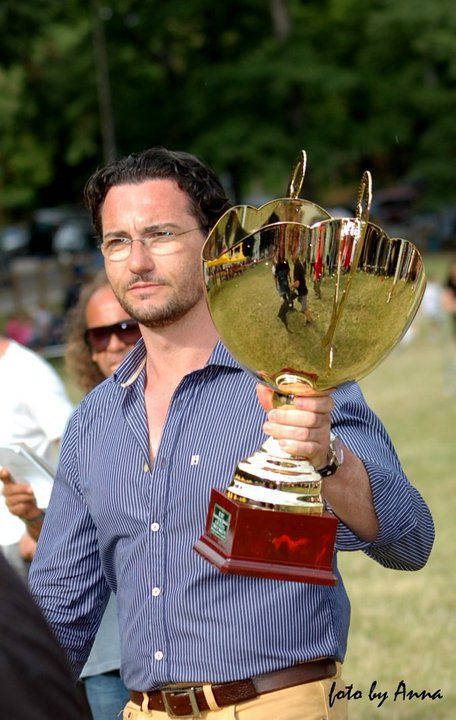
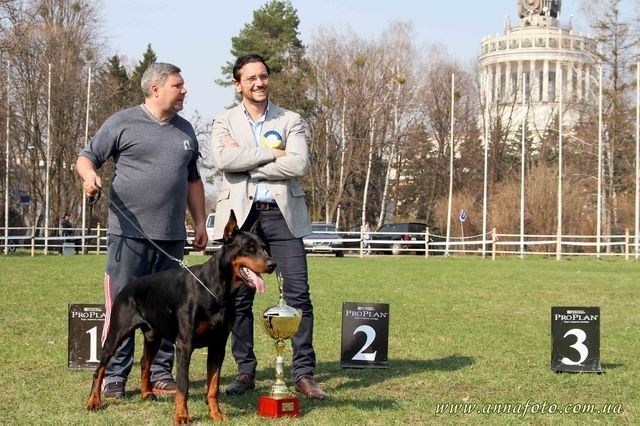
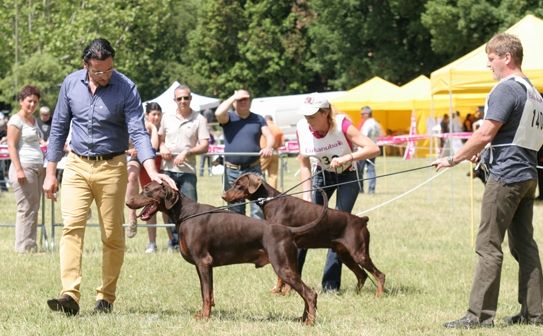
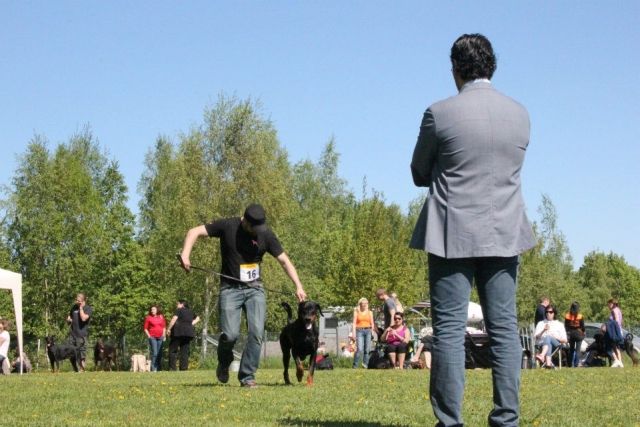
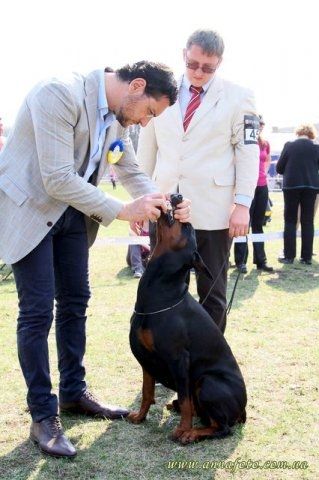
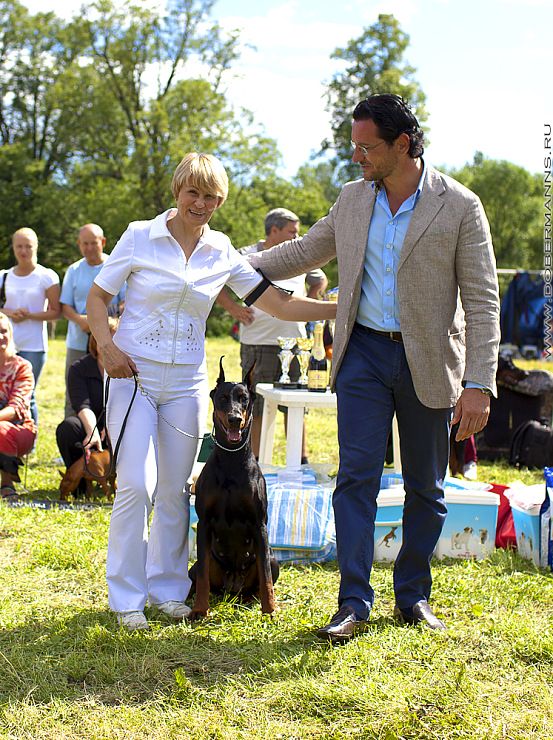








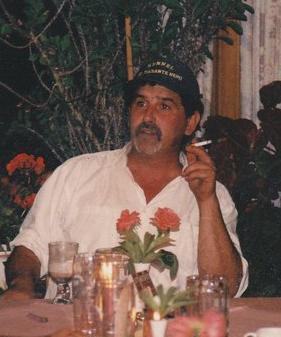
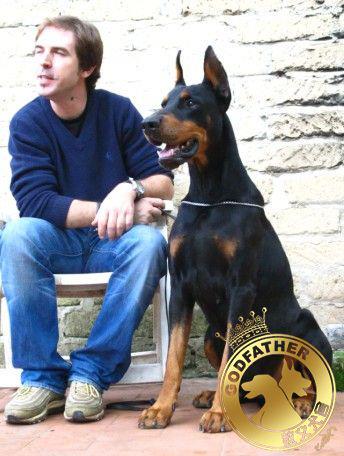
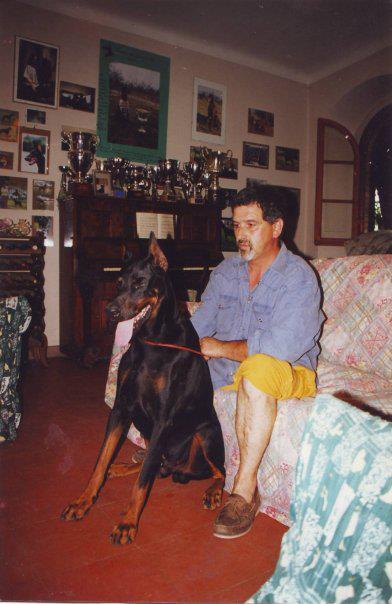
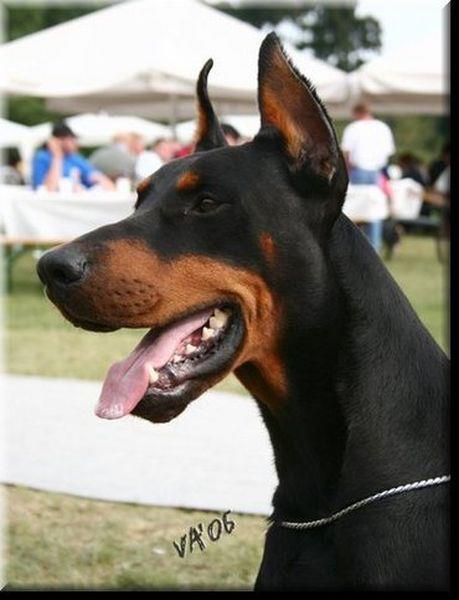
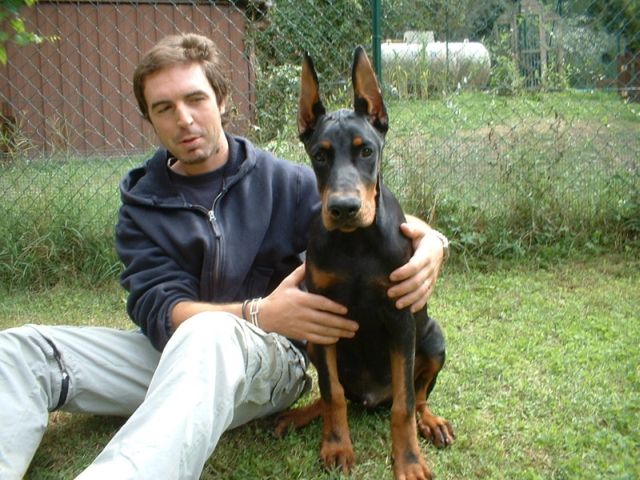
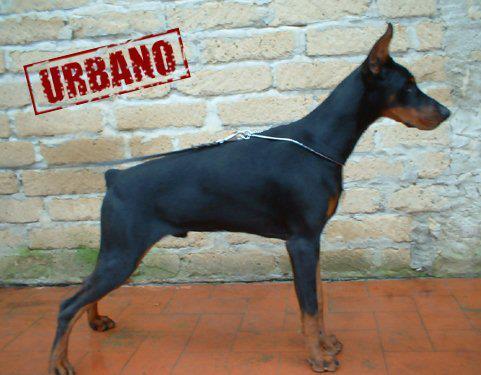
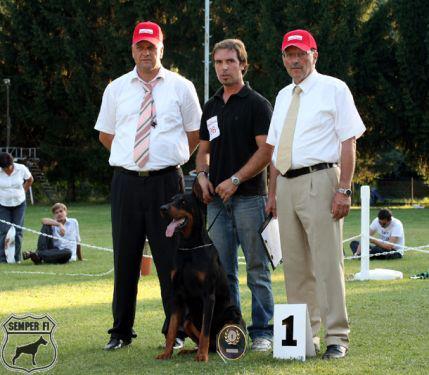
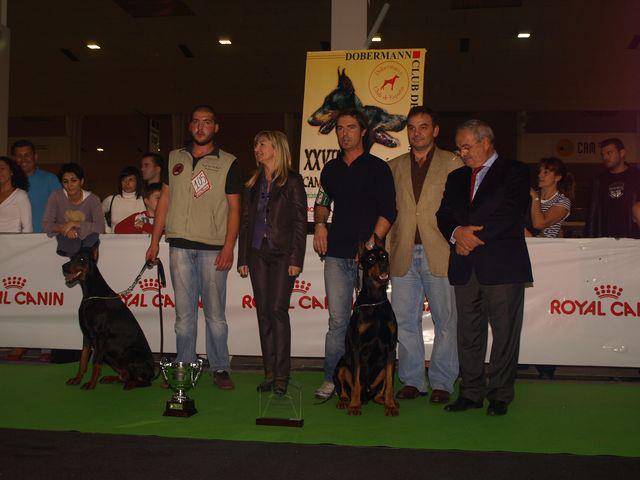
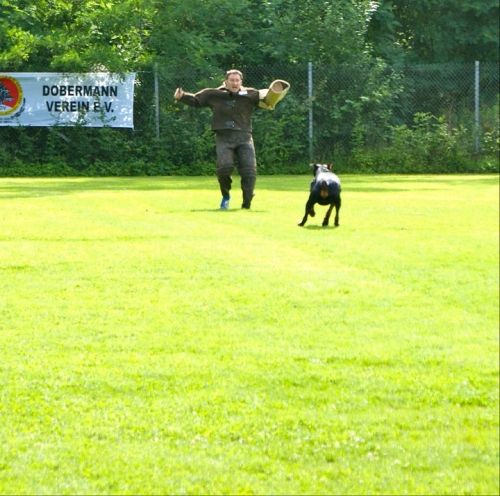
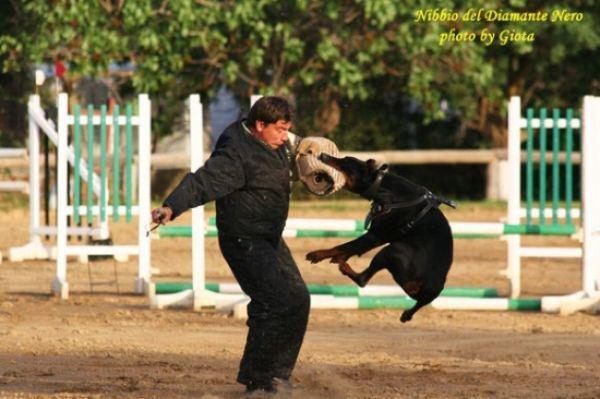
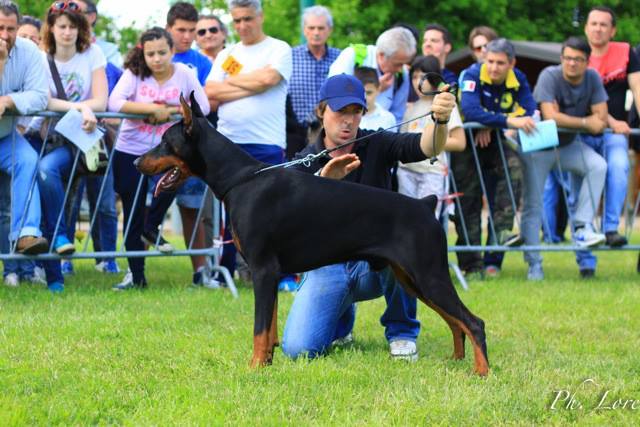
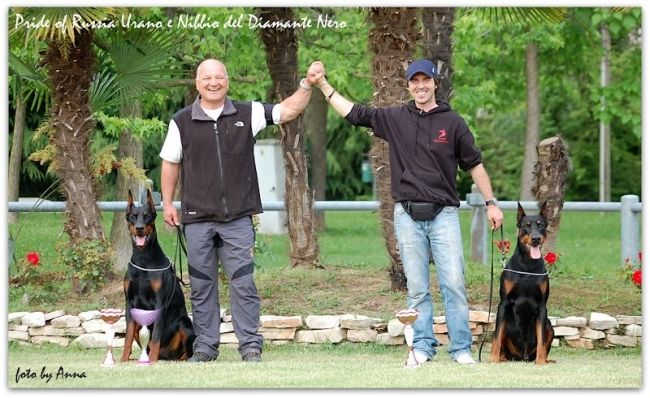
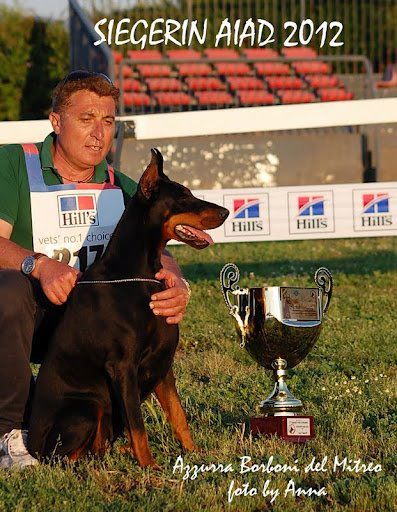
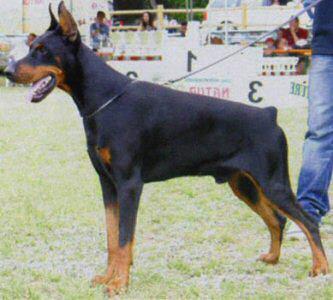
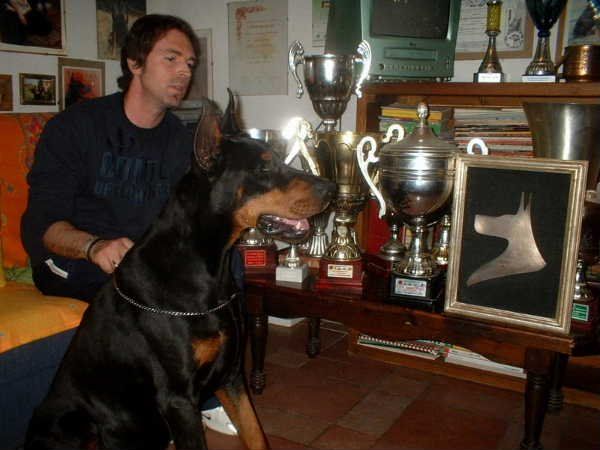
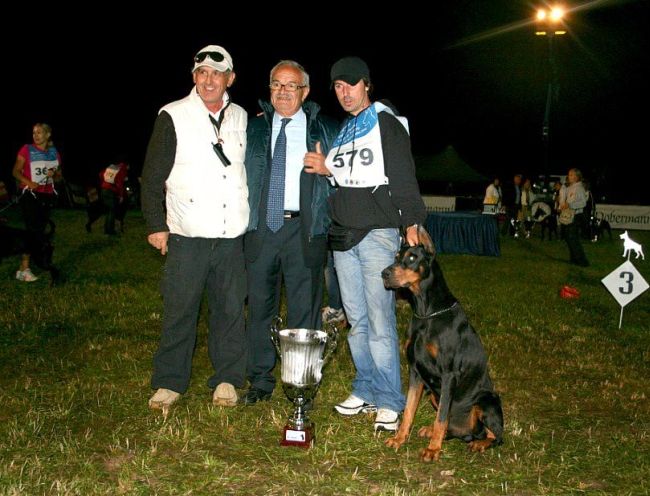
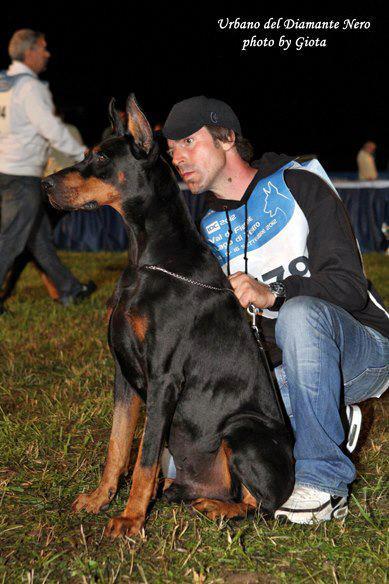
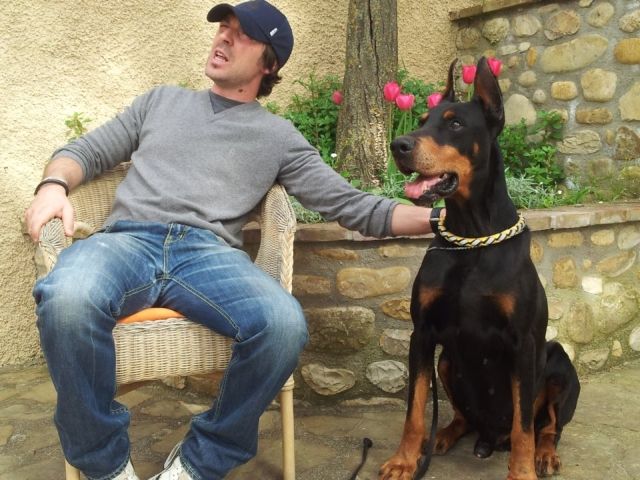
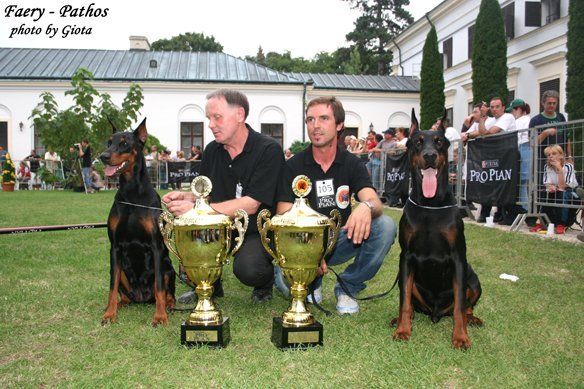
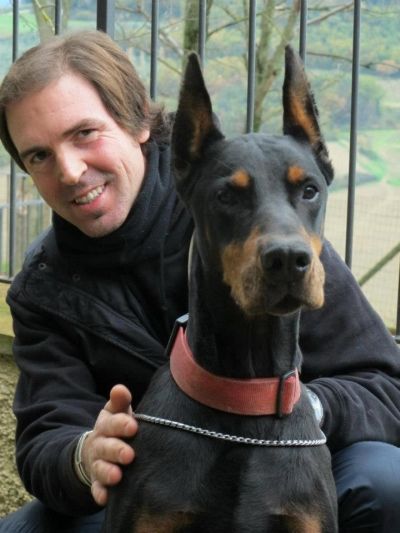
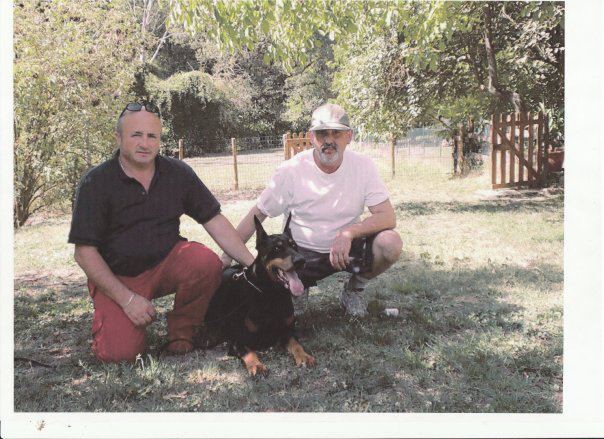
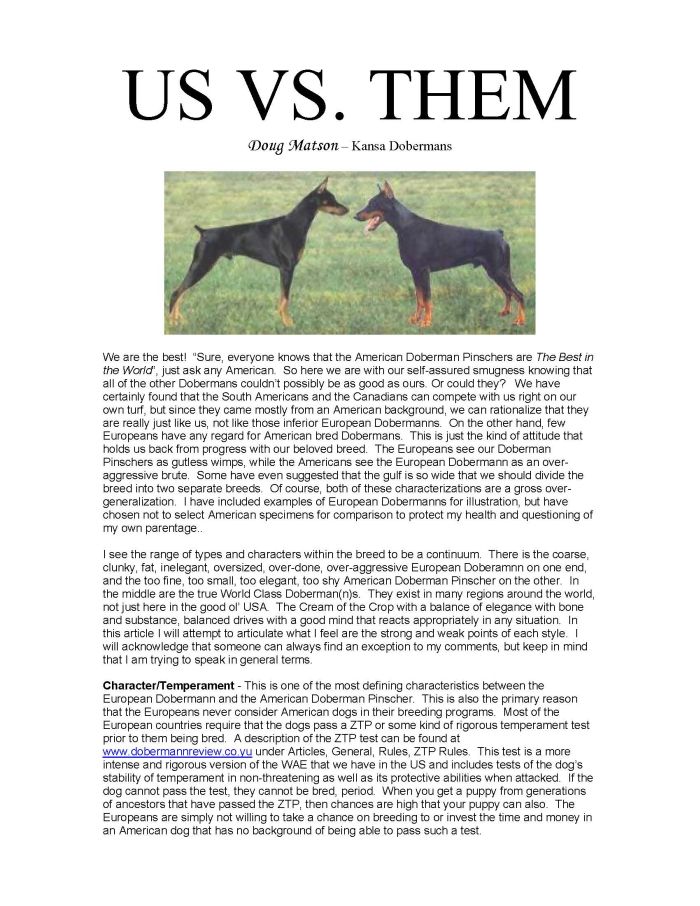
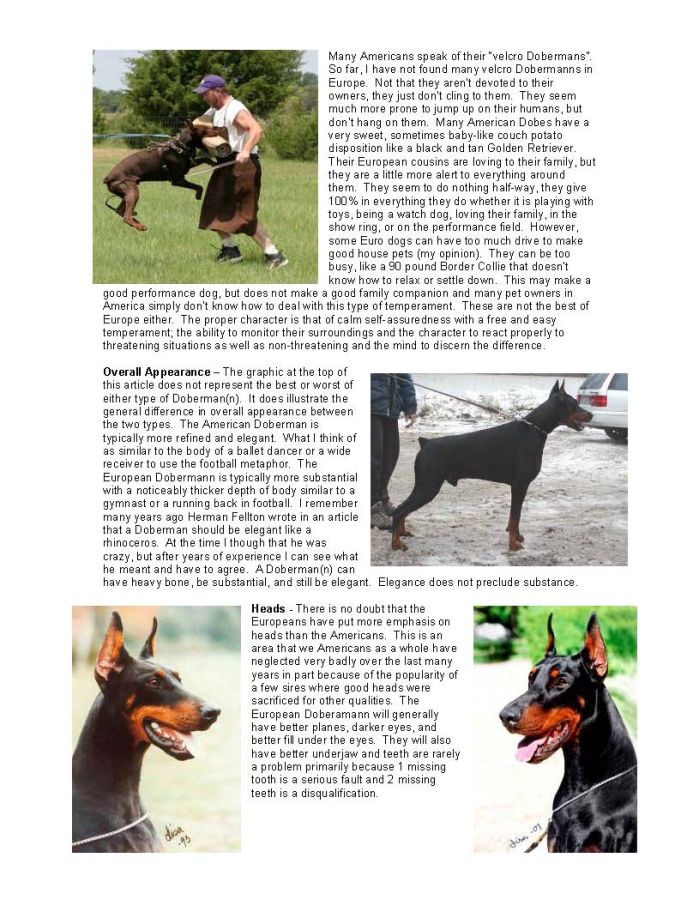
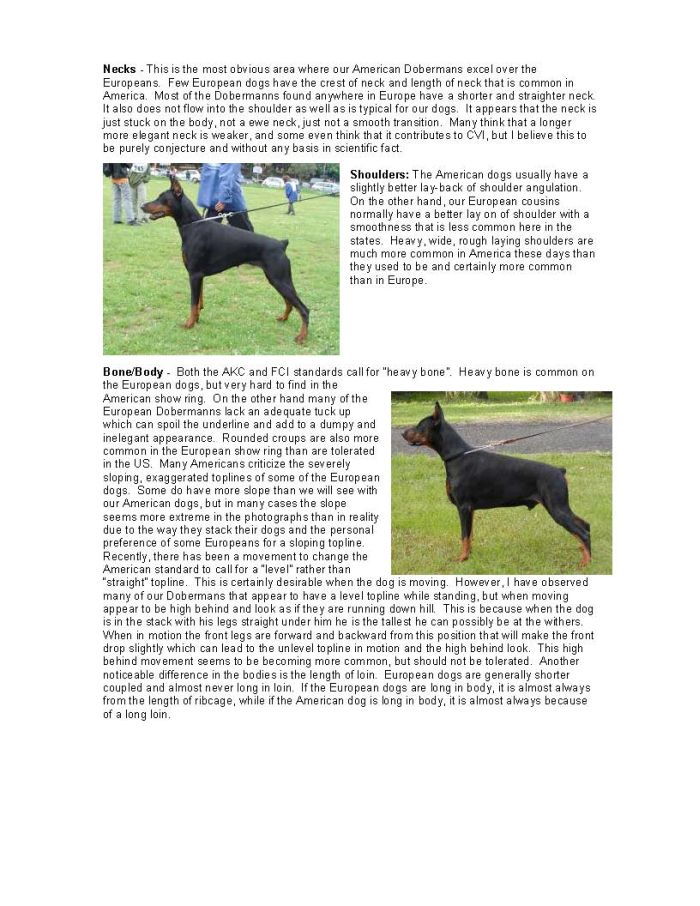
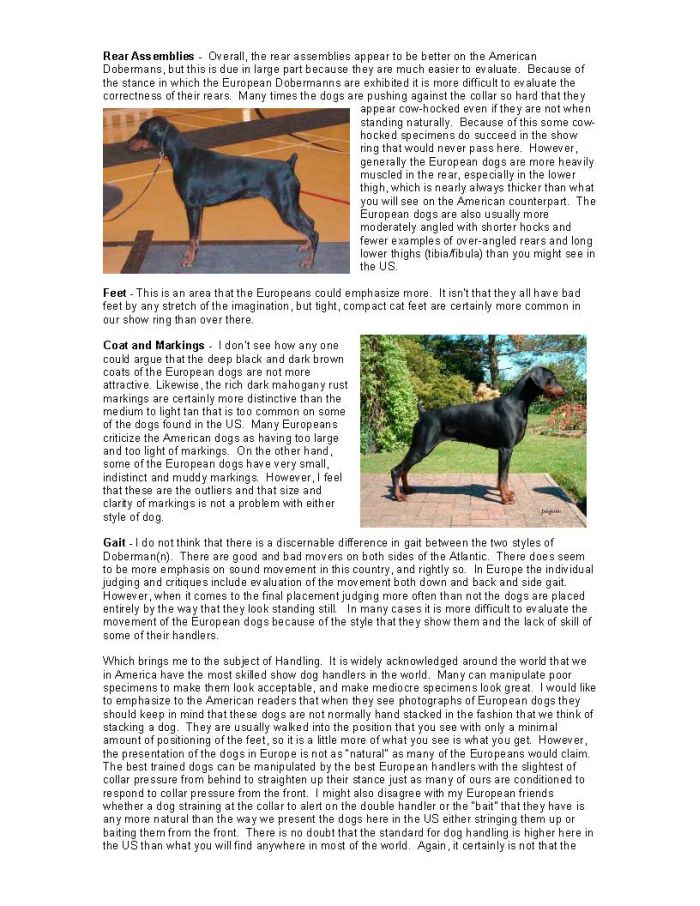
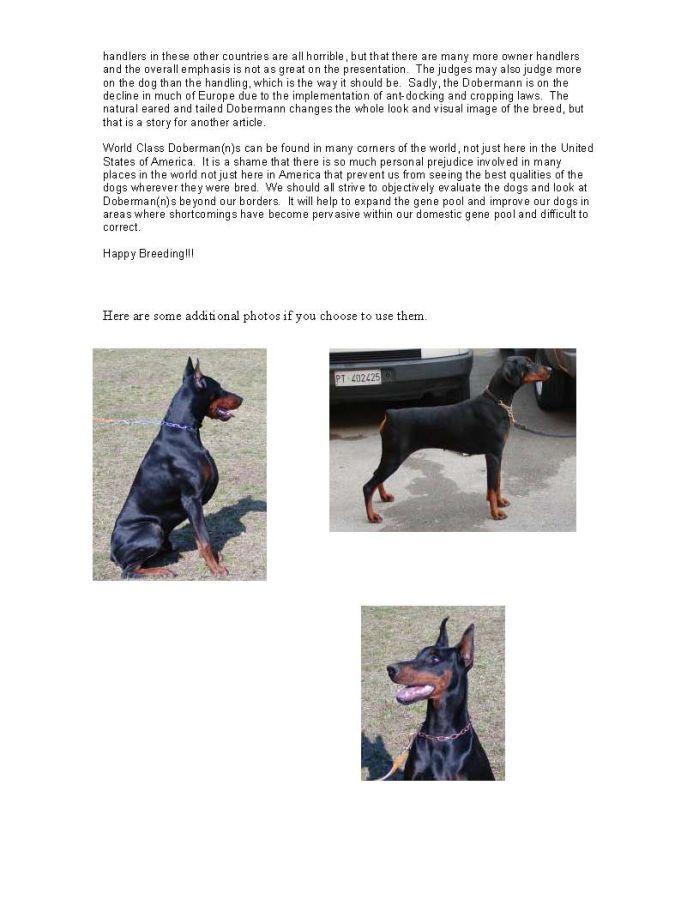
 The dobermann is also harmonious in his outlines, that must be straight, that’s to say without interruption or jolts or tooaccentuate height differences. The outlines that we must consider in the judgement are those of the head, the lips, the neck, the back, the croup, the legs, the chest and the abdomen.
The dobermann is also harmonious in his outlines, that must be straight, that’s to say without interruption or jolts or tooaccentuate height differences. The outlines that we must consider in the judgement are those of the head, the lips, the neck, the back, the croup, the legs, the chest and the abdomen.



 On the subject of tooth, it’s all right to pay attention to the alignment of the incisors during the first three years of life of the dog, but it would be more useful to pay the greatest care to the right shot between the incisors and the pre molars. In many dogs, the canines are too separated and the pre molars close badly. The judge should always notice these faults and penalize them according to their gravity.
On the subject of tooth, it’s all right to pay attention to the alignment of the incisors during the first three years of life of the dog, but it would be more useful to pay the greatest care to the right shot between the incisors and the pre molars. In many dogs, the canines are too separated and the pre molars close badly. The judge should always notice these faults and penalize them according to their gravity.
